Freshwater aquarium sharks offer a fascinating mid-spectrum body shape when compared to Asian dragon-like bettas and classic goldfish-cracker-shaped fish like tiger barbs.
Author Note: While these fish are not related to marine sharks, they do have fin structures and body shapes that remind people of true sharks. Fortunately, freshwater sharks are nowhere near as big or as dangerous as their namesakes!
Over the years, I have gotten to know several different freshwater shark species that you might find in the pet store including Red Tail Sharks and Albino Rainbow Sharks.
Since most freshwater sharks are either related to catfish or other barbs, I thought it might be useful to compare some of the more interesting ones from each family in this article.
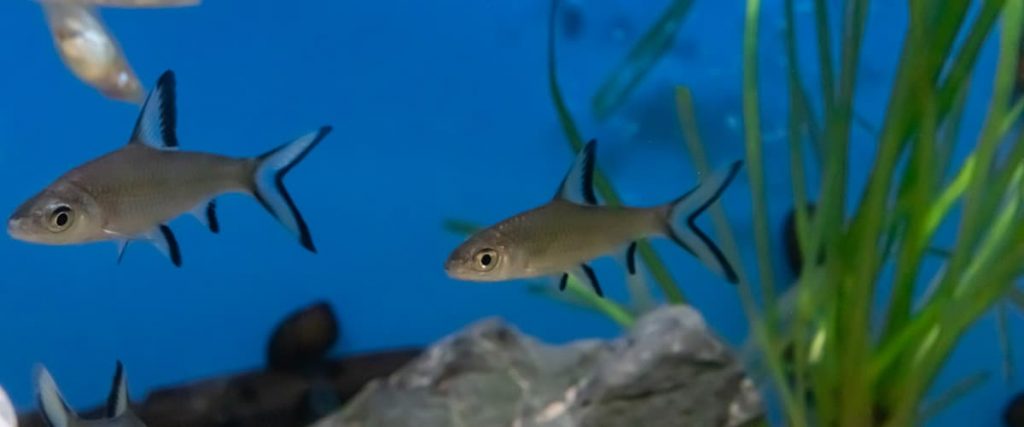
These elongated diamond-shaped fish have silvery bodies that look sleek and powerful. Their fins and tail are somewhat narrow and have vertical arrowed stripes on them.
Up close, you can definitely see where they are related to barbs. At distance, however, you can easily mistake them for miniature sharks.
| Water Temperature | 72 to 79 degrees fahrenheit |
| pH | 6.5 to 7.5 |
| Water Hardness | Hard |
| Optimal Tank Size | Freshwater Pond over 200 gallons |
| Maximum Size | 1’ 6” |
| Care Level | Medium |
| Other Names | Silver Shark, Shark Minnow, Tricolor Shark |
As with other members of the Cyprinidae family hailing from Borneo and Sumatra, Bala Sharks can be a bit feisty, however they are more like the minnow members of this family as opposed to the barbs.
It is best to house them with other peaceful fish that are about the same size.
Bala Sharks are omnivores and will do best when you feed them insects, insect larvae, and phytoplankton. They will accept flake and pellet foods, but will prefer frozen or live foods.
These fish need a varied aquascape in order to keep their agile minds occupied. Their natural habitat is usually filled with patches of dense plants and open water, caves, driftwood, and rocks.
If your specific fish are more comfortable in the acidic side of the pH range, then you might want to try adding some tannins to the fish tank to see if they like it.
Even though Bala Sharks are attractive creatures, they are an endangered species in their wild habitat. Aside from overfishing, the wild populations also suffered a great loss when forest fires damaged the surrounding ecosystem.
Author Note: If this becomes one of your favorite freshwater fish, you might want to consider breeding them professionally as part of a rehabilitation program.
Unlike some other freshwater sharks, Bala Sharks are not especially difficult to breed in captivity.
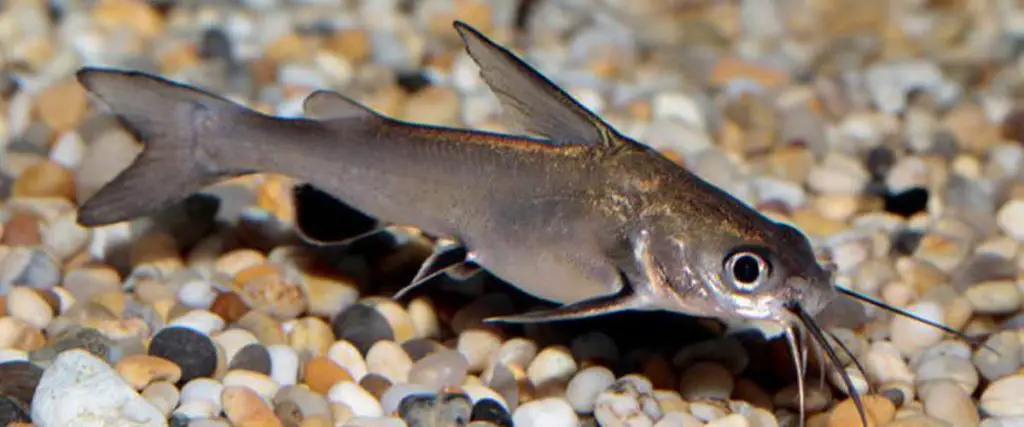
When you first look at a Colombian Shark, you will almost immediately recognize the barbels that mark it as a member of the catfish family.
That aside, this fish’s slender body and shiny gray coloration looks very shark-like. It’s triangular dorsal fin can also make people look twice, especially if the fish is first seen in your freshwater tank from a distance.
| Water Temperature | 75 – 80 degrees fahrenheit |
| pH | 7 – 8 |
| Water Hardness | Medium to hard |
| Optimal Tank Size | 250 gallon tank or more for multiple fish |
| Maximum Size | 20 inches |
| Care Level | Difficult |
| Other Names | Black Fin Shark, Jordan’s Catfish, West American Cat Shark, Christian Catfish, Silver Tipped Shark, Jordan’s Catfish |
Columbian Sharks are in the Catfish family. They come from Mexico, Central America, and South America. They are similar to their other Catfish relatives in the sense that they tend to range from peaceful to semi-aggressive.
They will leave other fish in the tank alone, as long as they are about the same size. Unfortunately, though, they enjoy snacking on fish that are smaller than them.
Insofar as nutritional requirements are concerned, Columbian Sharks are mainly carnivorous bottom feeders that prefer to scavenge for their food.
Top Tip: They will do best with live or frozen meat-based foods such as blood worms, brine shrimp, and tubifex worms. You can also give them staple sinking pellets made for catfish.
As with other members of the Catfish family, Columbian Sharks tend to stay at the bottom of the tank. They will still come up to the mid and upper levels for food or if something gets their attention.
For the most part, this silver shark does well with plenty of open space to swim around near the bottom of the tank. They still need caves and overhangs for hiding places, and plants to explore.
While Columbian Sharks are quite attractive, they are not suitable for beginning aquarium keepers. Here are a few things to consider before buying them:
- The water chemistry needs of Columbian Sharks changes over the course of their lifetime. While younger animals will do OK in freshwater, they will eventually need brackish water, and then salt water once they reach maturity. If you aren’t ready to setup a fairly large marine or saltwater tank, then this shark fish may not do well at all in your home aquarium.
- Columbian Sharks have poisonous spines. If you must put your hands in the community tank, never forget that the fish may see this as an invasion of its territory, or it may become frightened. Either situation can lead to you getting stung. Always keep an antidote kit near the tank in case you get stung. It is also important to wear gloves that will cover any part of your hands and arm that may get into the tank.
- Finally, all Columbian Sharks available for home aquariums are wild caught. It is virtually impossible to breed them in a captive setting because the fish are accustomed to travelling large distances to spawn. They are likely to be moving between fresh, brackish, and saltwater locations over time.
It is very hard to mimic both the distance traveled and the gradual water chemistry changes that happen in nature.
Therefore, even though male Columbian Sharks are mouthbrooders, you may never get a chance to help rear fry to maturity.
If you are up for a challenge, however, this may be the perfect fish for you to try out once you have more experience with other fish.

This fish has a long, torpedo-like body that makes many people think of sharks. It’s coloring, however, is much more koi-like. Almost all Harlequin sharks have brown or black mottling along with yellow or orange patches.
Other than it’s somewhat triangular fins, this one doesn’t look as shark-like in an aquarium setting as some other fish that are sold as freshwater sharks.
| Water Temperature | 70 – 81 degrees fahrenheit |
| pH | 6.0 to 7.5 |
| Water Hardness | Soft, medium, and hard |
| Optimal Tank Size | Around 50 gallons |
| Maximum Size | 6 inches |
| Care Level | Medium |
| Other Names | Harlequin Sharkminnow |
This fascinating member of the Cyprinidae family comes from the Congo region of Africa. It has a lot of Koi coloring to it, which may make you think it is more related to the carp side of the family than to minnows or barbs.
Temperament wise, however, Harlequin Sharks tend to be quite aggressive, and are thus much closer to barbs.
Even though this fish is quite hardy, it can be difficult finding suitable tankmates. Harlequin Sharks are extremely territorial among their own kind, and also towards other species of fish.
Since this fish mainly swims in the lower and mid-levels of the tank, you can try housing it with fish that are more inclined to stay at the top of the tank.
Bear in mind, however, fish that don’t feel well, or are interested in spawning may go to the bottom of the tank. If they do, rest assured the Harlequin Shark will seek to do as much damage to the invader as possible.
For the most part, Harlequin Sharks are omnivores. In their native habitat, they will usually dine on algae and microscopic animals.
In an aquarium, they will do best with live or frozen foods including daphnia and bloodworms.
They will also do well if you feed them peas, spinach, and cucumbers. You can also feed them staple pellets or flakes, but they may wait until the food sinks to the bottom, or, at a minimum, the mid-level of the tank.
Color-wise, Harlequin Sharks are made to blend in with dark substrate, rotting wood, and caves covered in biofilm.
They also tend to be more comfortable in tannin rich tanks, since the waters they originate from are found deep in the rainforest.
It is best to keep them in aquariums with plants that produce a lot of leaves. Be sure to leave at least some areas unkempt so the fish can explore, hide, and set up a territory that feels comfortable.
Insofar as substrate, these fish will do best with dark-colored sand that is covered over with a lot of plant litter.
These fish will be more than happy to clean inside caves and dig through the detritus in search of algae and tiny meat bearing organisms.
At the current time, Harlequin Sharks have not been successfully bred in captivity. Much of the problem revolves around finding a way to introduce male and female fish, and then have them get along well enough to spawn.
Author Note: For the time being, Harlequin Sharks are not considered endangered in their natural habitat. Nevertheless, just about every rain forest in the world is under pressure from logging and other forms of human activity and they could easily become so..
Therefore, if you are interested in keeping this fish, it might be better to wait until you are sure that you have sufficient skill and experience with aquarium keeping.
From there, you can always do some additional research on how Harlequin Sharks reproduce, and perhaps figure out a way to breed them in captivity.
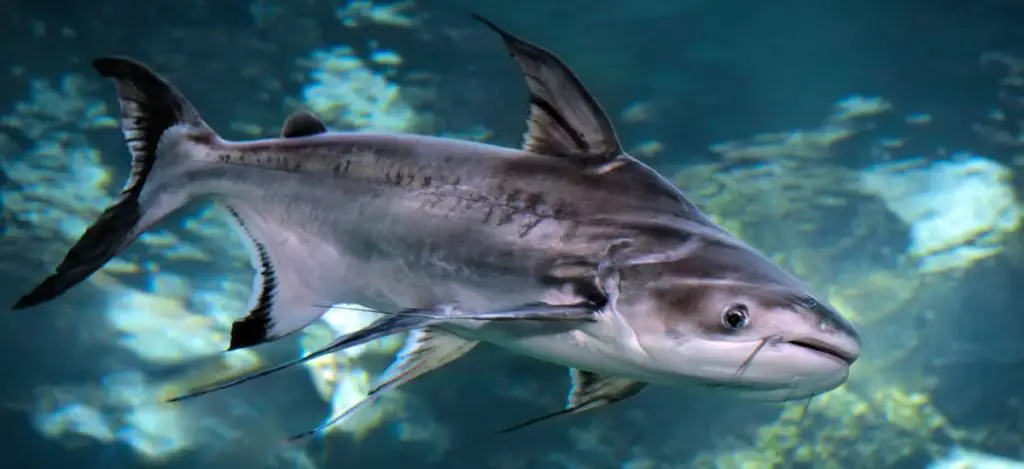
Of all the fish sold as freshwater sharks, this one is almost a perfect match appearance-wise to saltwater sharks.
Iridescent sharks have a long, elongated diamond-shaped body with light grey shading that fades to white near the back of the fish. It has darker grey triangular fins and tail.
Unlike other freshwater sharks, this one also looks like a real shark close up. With its pointed nose, the position of its eyes, and the receding jaw, it can easily pass for a juvenile Great White Shark.
Author Note: Fortunately, neither its teeth nor its size are anywhere near as dangerous!
| Water Temperature | 72 – 79 degrees fahrenheit |
| pH | 6.5 to 7.5 |
| Water Hardness | Soft to medium |
| Optimal Tank Size | Pond |
| Maximum Size | Up to 4 feet in length |
| Care Level | Medium to difficult |
| Other Names | Thailand Catfish, Sutchi Catfish, Siamese Shark, Asian Catfish |
Iridescent Sharks are a member of the catfish family. They were originally discovered in the depths of the Mekong River in Thailand. Overall, they are shy, peaceful creatures that will readily school with their own kind.
Since they can get quite large, however, and enjoy living in the central region of the tank, it is best to avoid housing them with small fish.
In a natural setting, Iridescent sharks will eat just about anything, including small fish. They will also eat shrimp, and just about anything else that moves around in the tank.
As Iridescent Sharks age, they will lose their teeth. This, in turn, means that food choices may change over time. For example, when they are young, feeding them frozen meat-based foods will work better.
Tubifex worms, blood worms, and daphnia will all suit this fish well.
Do not forget to include vegetables, since this fish also needs a good bit of vegetable matter in order to remain healthy. Once this fish loses its teeth, you can feed them soft vegetables and less meat.
This fish will also accept flake and pellet based food. Just be sure that at least some of the food stays in the central level of the tank.
Unlike other members of the catfish family, Iridescent Sharks prefer the mid-level of the tank instead of the bottom. The mid-level is also where they prefer to eat and hunt for food.
Author Note: Since these are fairly large, active fish, they need a good bit of room to swim.
With most other species of schooling fish, you can create patches of planted and open areas that extend pretty much from the bottom of the tank to the top.
When it comes to Iridescent Sharks, you will need plenty of room in the mid-level of the tank.
Try using short plants or carpet plants that will not reach into the mid-level of the tank, and then put floating plants on top to give these fish some relief from bright lights.
They will do fine with caves and driftwood, as long as they are located in areas where they will look for hiding spots as opposed to creating obstructions to swimming.
As with several other freshwater sharks, Iridescent Sharks cannot be bred in captivity.
The biggest challenge with this fish is that it has to migrate over long distances (well over 100 miles) before it will breed.
As the fish moves from one region to another, there are gradual changes in the water parameters, temperature, and water depth.
While this fish will do fine living in the central region of a pond, they are still very aware of how deep the water actually is.
Unless you can fool them into thinking the water depth is changing along with many other elements of the environment, chances are you will not be able to get this fish to breed.
Unfortunately, this beautiful fish is also a globally endangered species. Its natural habitat is threatened by various kinds of human activity.
At the same time, it doesn’t tend to establish itself well in foreign water conditions. While there may be some fish released from aquariums, there are no proven records of it reproducing in a new setting.
Although this fish is peaceful, and not always difficult to care for, it does need a pond setting.
Author Note: I don’t recommend this fish for beginners mainly because it must be taken from wild populations that are already under considerable threat of extinction.
Since this fish has not been successfully bred in captivity, there is, certainly, a lot of room for new ideas and approaches.
This may include everything from looking for ways to replicate underwater odors, sounds, and other water changes that may fool the fish into thinking it has traveled a great distance.
And most importantly, that it has arrived at a location where it can spawn.
Once you are at a level where you have a good bit of experience with breeding and keeping fish in large tanks, then you might want to look into research around breeding this fish.
One thing is for certain, it is a beautiful fish that many aquarium keepers would love to have.
At the same time, there is a good bit of interest in finding ways to preserve this species in its native setting, and perhaps introduce more fish to help with genetic diversity in a natural setting.
If there is one, often hidden benefit of the aquarium keeping hobby, it lies in the possibility that one day you may come up with something to help an endangered species.
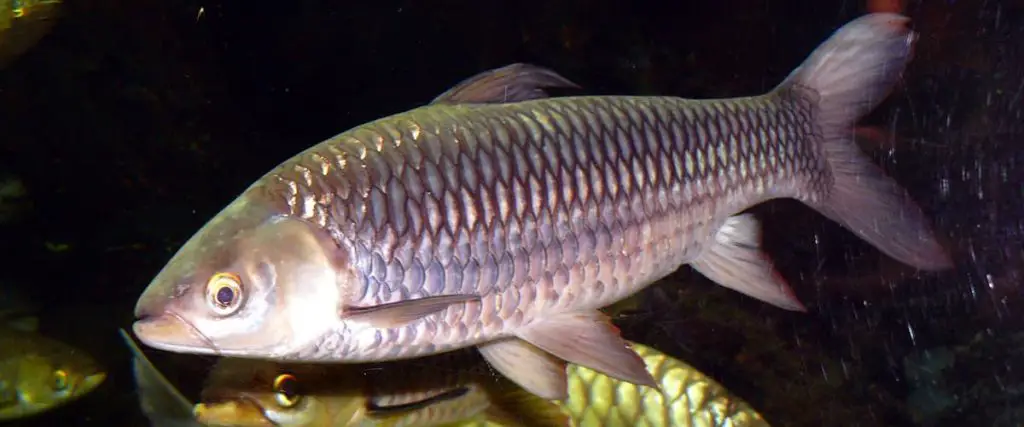
At first glance, this fish reminds me of a Buenos Aires Tetra because of its long silvery body and the red markings on its fins.
All its is missing is the classic tetra mouth and the diamond markings near its tail region.
| Water Temperature | 68 – 79 degrees fahrenheit |
| pH | 6.0 to 8.0 |
| Water Hardness | Medium to hard |
| Optimal Tank Size | Pond |
| Maximum Size | Up to 4 feet long. |
| Care Level | Medium to difficult |
| Other Names | Sultan Fish, Mad Barb, Maroon Shark, Cigar Shark |
Red Finned Cigar Sharks come fast-running rivers in Cambodia, Vietnam, Thailand, Laos, and other parts of Southeast Asia. They are members of the Cyprinidae family.
Appearance-wise, they somewhat resemble the barb side of the family, however, their temperament is much closer to the carps.
These are fairly peaceful fish that will get along Ok with other peaceful fish that are the same size as them. It is best to avoid putting them with smaller fish because they will eat them.
In a wild setting, Red Finned Sharks will eat a wide range of foods. They are omnivores that will easily dine on plants, invertebrates, other fish, and anything else that seems edible.
Given how large they get, you will need to pay a considerable amount of attention to ensure they have a wide range of food choices on a daily basis.
You can combine frozen fish food such as blood worms and tubifex worms, as well as give them staple pellets and flake food. They will also do better if you give them fresh vegetables such as cucumber, spinach, and some fruit.
As with many other large-sized freshwater sharks, Red Finned Cigar Sharks are accustomed to swimming long distances. They will also need large open areas in the mid-level of the pond or tank.
You can add smaller plants, driftwood, and rounded rocks in the bottom area of the pond, and then floating plants at the top.
At the current time, this fish is not considered an endangered species. Nevertheless, it is similar to the Iridescent Shark in its need to travel long distances to spawn. Therefore, any animals that you purchase will be wild-caught.
Author Note: It is best to make sure that you have the skills, experience, and budget required to take care of this fish in a pond setting.
There is no question that freshwater sharks represent a diverse group of tropical freshwater fish.
No matter whether you are looking for a small fish with a different look, or you want to expand into tanking care of larger tanks and ponds, there is sure to be a species of interest to you.
Depending on your long-range aquarist interests, you may also be interested in learning how to care for one or more species that is endangered in its natural habitat and looking for ways to help revive native populations.
Alternatively, some of these fish cannot be bred at this time in captivity, so if you can find a means to achieve that goal, you will be contributing something worthwhile to the body of knowledge surrounding aquarium fish care and keeping.
FAQs about Freshwater Sharks
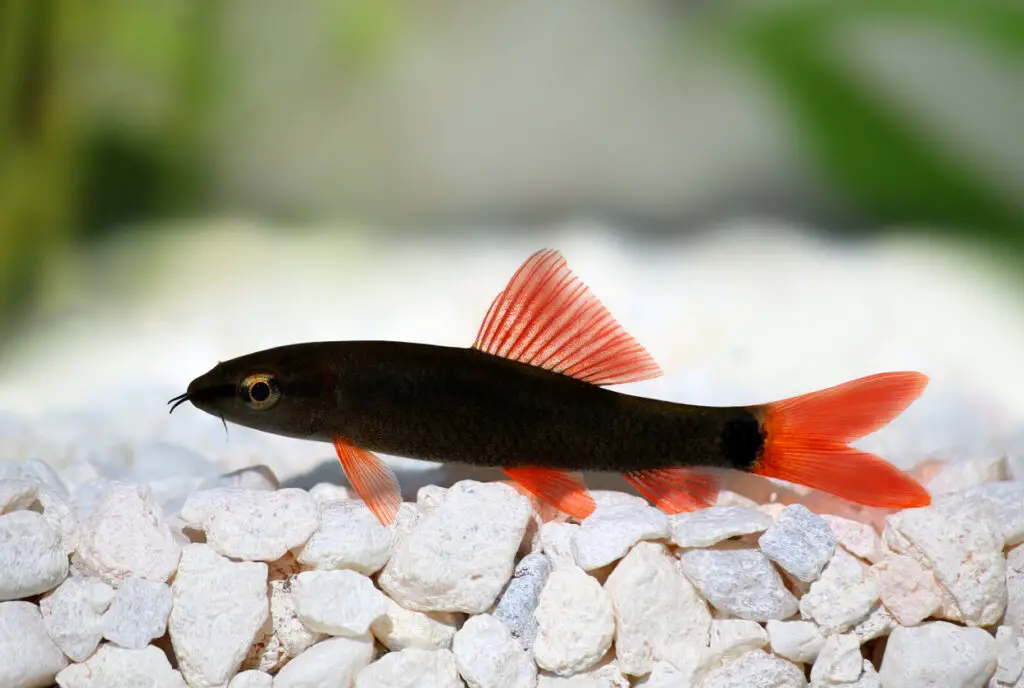
For those looking for more information, these FAQs should help you sort some things out as you consider bringing home and caring for freshwater sharks.
Aren’t all sharks saltwater fish?
True sharks from the condrichthyes family of ocean dwelling fish are, yes, saltwater beings. However, freshwater sharks are not of the same family.
However, there are actually some freshwater sharks like some varieties of bull sharks and river sharks. These are the kind of fish we’re talking about in this article, either, however.
These freshwater sharks are just nicknamed sharks. They are part of the cyprinidae or catfish families.
They are bony fish and unrelated to the typical creatures most think of when they hear the word “shark.”
They are called sharks because of their appearance, making them look a bit like tiny versions of the sea creatures famously found in films like Jaws.
Freshwater sharks are also known as sharkminnows.
If they’re not real sharks, are they still dangerous?
Freshwater sharks in the fishkeeping industry are not dangerous species of fish. They are, in essence, harmless minnows.
Now, that doesn’t exclude the fish from being aggressive towards other fish species or even their own kind.
They just can’t harm humans. They’re way too small and not nearly aggressive enough to hurt you, since this isn’t a weird sci-fi flick.
What else should I know about these little guys then?
Probably the most important thing to know about freshwater sharks is that they vary widely by species. Rainbow sharks, for example, don’t need the same care parameters that bala sharks do.
It’s important to research the specific species of shark you’re bringing home for your aquarium.
